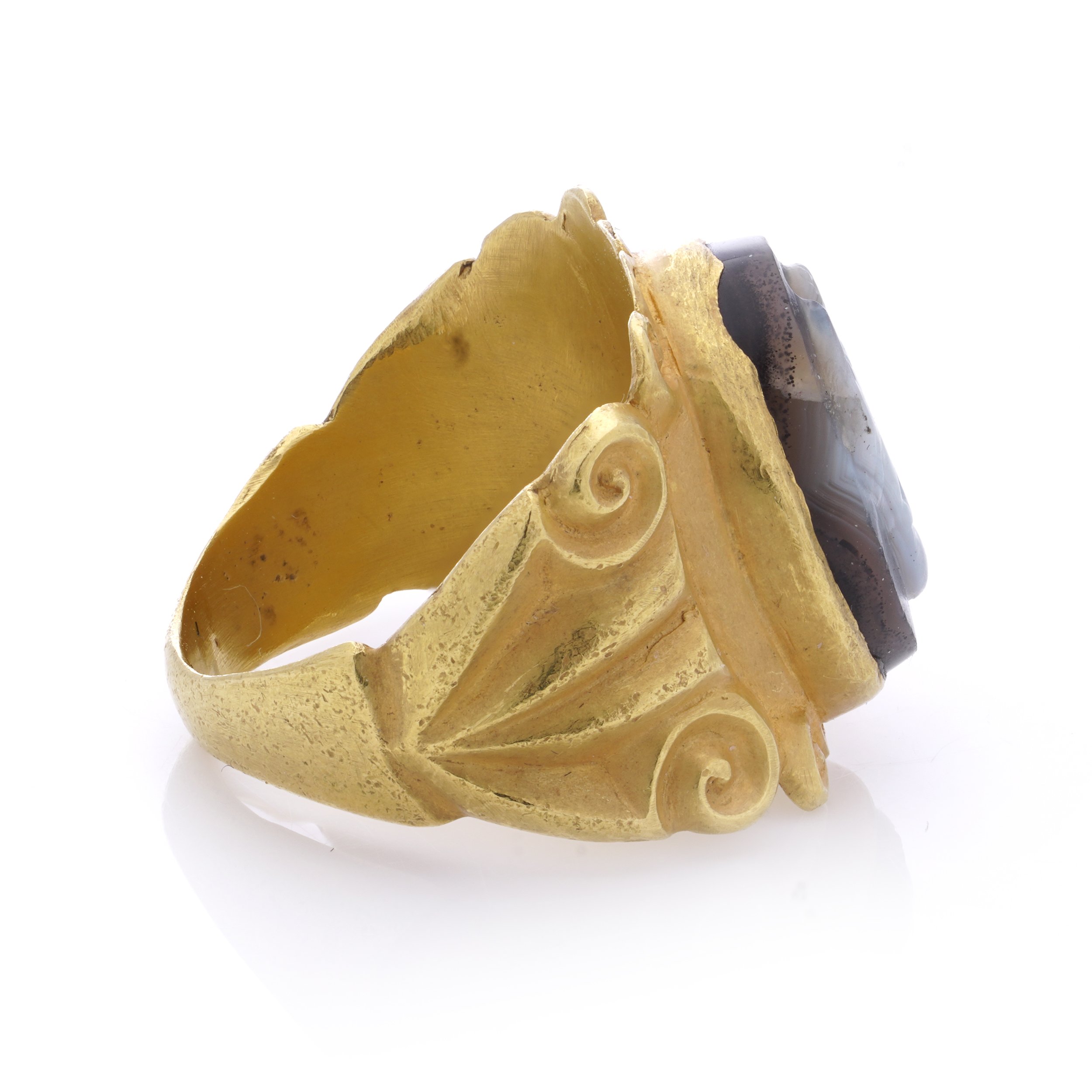22kt. gold men's ring with Chalcedony, featuring Eros riding a dolphin
Antique 19th century 22kt. yellow gold men's band ring with Black and white Chalcedony, featuring Eros ( Cupid ) riding a dolphin.
Antique 19th century 22kt. yellow gold men's band ring with Black and white Chalcedony, featuring Eros ( Cupid ) riding a dolphin.
Antique 19th century 22kt. yellow gold men's band ring with Black and white Chalcedony, featuring Eros ( Cupid ) riding a dolphin.
-
Antique 19th century 22kt. yellow gold men's band ring with Black and white Chalcedony, featuring Eros ( Cupid ) riding a dolphin.
Made in Circa 1890's
-
Finger Size (UK) = O (EU) = 56 (US) = 7.5
Weight: 13.00 gramsThe ring is pre-owned with minor signs of use, in good and pleasant condition overall.
-
History
In various depictions throughout ancient and later artistic representations, Cupid is frequently depicted in tandem with a dolphin. On ancient Roman sarcophagi, this imagery might symbolize the journey of the soul, originally intertwined with Dionysian beliefs. A mosaic discovered in late Roman Britain illustrates a procession emerging from the mouth of the sea god Neptune, starting with dolphins and followed by sea birds, ultimately culminating in the presence of Cupid. One interpretation of this allegory suggests that Neptune symbolizes the soul's origin in the fundamental substance from which life was moulded, with Cupid reigning victorious as the soul's sought-after destiny.In alternate contexts, the portrayal of Cupid alongside a dolphin takes on a more playful tone, such as in the garden statuary found in Pompeii. Here, dolphins are depicted rescuing Cupid from an octopus, or Cupid himself holding onto a dolphin. The dolphin, sometimes depicted in elaborate and fantastical forms, might serve as a spout for a fountain. Notably, on a contemporary fountain in the Palazzo Vecchio in Florence, Italy, Cupid appears to be engaged in an unusual act of seemingly strangling a dolphin.
Dolphins, recognized in antiquity as friendly beings towards humans, often symbolize affection. Pliny recounts a story of a dolphin in Puteoli carrying a boy on its back across a lake every day to attend school; when the boy passed away, the dolphin reportedly grieved itself to death.
In scenes of erotic nature from mythology, the representation of Cupid riding a dolphin may convey the swift and unpredictable nature of love, or Cupid astride a sea creature may serve as a comforting presence amid the tumultuous journey of love. A Cupid riding a dolphin might be present in depictions of Neptune and Amphitrite's wedding or the Triumph of Neptune, also known as a marine thiasos.
In antique rings, the depiction of Eros or Cupid riding a dolphin holds symbolic significance, drawing upon the attributes associated with both figures. This representation often conveys themes of love and desire, blending the playful and joyful nature of dolphins with the romantic and passionate essence embodied by Eros. The combination of these symbols suggests a love that transcends boundaries, whether they be earthly or heavenly, and signifies the harmonious balance of love and desire. The aquatic element, linked to the sea and Poseidon, adds a dimension of connection between love and the profound, sometimes unpredictable, depths of emotion. Furthermore, the image may evoke notions of fertility and renewal, aligning with the associations of dolphins with these themes. It's crucial to recognize that interpretations can vary, and the specific meaning of such imagery in antique rings is influenced by the cultural and artistic context of the era in which the jewellery was created, reflecting the prevailing beliefs and values of that society. -
TEM LOCATION : United Kingdom
SHIPPING FEE: Complimentary Express & Insured Shipping
INCLUDED: Complimentary Gift Wrap Packaging & Certificate of Evaluation.
RETURNS: 14-Days Return Policy, Money-Back Guarantee.









